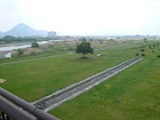
Yasu River
Encyclopedia
The is located in Shiga Prefecture
, Japan
; it is the largest river to flow into Lake Biwa
. It rises from Mount Gozaisho
and flows through Kōka
, Konan
, Rittō
, Moriyama
and Yasu
. It forked at the lower reaches and made a delta region, but they were combined in 1979.
, one of the Edo Five Routes
which connected east and west Japan during the Edo period
, paralleled the river. Post towns
along the river included Tsuchiyama-juku
, Minakuchi-juku
and Ishibe-juku
. The Yasu River also crossed the Nakasendō
, another one of the Edo Five Routes, separating Moriyama-juku
and Musa-juku
.
Shiga Prefecture
is a prefecture of Japan, which forms part of the Kansai region on Honshu Island. The capital is the city of Ōtsu.- History :Shiga was known as Ōmi Province or Gōshū before the prefectural system was established...
, Japan
Japan
Japan is an island nation in East Asia. Located in the Pacific Ocean, it lies to the east of the Sea of Japan, China, North Korea, South Korea and Russia, stretching from the Sea of Okhotsk in the north to the East China Sea and Taiwan in the south...
; it is the largest river to flow into Lake Biwa
Lake Biwa
is the largest freshwater lake in Japan, located in Shiga Prefecture , northeast of the former capital city of Kyoto. Because of its proximity to the ancient capital, references to Lake Biwa appear frequently in Japanese literature, particularly in poetry and in historical accounts of battles.-...
. It rises from Mount Gozaisho
Mount Gozaisho
is a Japanese mountain located on the border of Komono, Mie Prefecture and Higashi-Ōmi, Shiga Prefecture.This mountain is the center of Suzuka Quasi-National Park.-Outline:...
and flows through Kōka
Koka, Shiga
is a city located in the southern part of Shiga Prefecture, Japan....
, Konan
Konan, Shiga
is a city located in the southern part of Shiga, Japan. The city was founded on October 1, 2004 by the merger of the towns of Kōsei and Ishibe, both from Kōka District. The total area is 70.49 km²....
, Rittō
Ritto, Shiga
is a city located in Shiga, Japan. It is well-known for Japanese horse racing fans because there is the Japan Racing Association's training center and a famous jockey brothers, Yutaka Take and Koshiro Take, were born in Ritto....
, Moriyama
Moriyama, Shiga
is a city located in Shiga Prefecture, Japan.As of August 1, 2011, the city has an estimated population of 77,384 and the density of 1,390 persons per km². The total area is 55.73 km²....
and Yasu
Yasu, Shiga
is a city located in Shiga Prefecture, Japan. The city was formed on October 1, 2004, by the merger of the towns of Yasu and Chūzu; in doing so, the former Yasu District was dissolved....
. It forked at the lower reaches and made a delta region, but they were combined in 1979.
History
The TōkaidōTokaido (road)
The ' was the most important of the Five Routes of the Edo period, connecting Edo to Kyoto in Japan. Unlike the inland and less heavily travelled Nakasendō, the Tōkaidō travelled along the sea coast of eastern Honshū, hence the route's name....
, one of the Edo Five Routes
Edo Five Routes
The were the five major roads that started at Edo during the Edo period, the most important of which was the Tōkaidō, which linked Edo and Kyoto...
which connected east and west Japan during the Edo period
Edo period
The , or , is a division of Japanese history which was ruled by the shoguns of the Tokugawa family, running from 1603 to 1868. The political entity of this period was the Tokugawa shogunate....
, paralleled the river. Post towns
Shukuba
were post stations during the Edo period in Japan, generally located on one of the Edo Five Routes or one of its sub-routes. They were also called shukueki . These post stations were places where travelers could rest on their journey around the nation...
along the river included Tsuchiyama-juku
Tsuchiyama-juku
was the forty-ninth of the fifty-three stations of the Tōkaidō. It is located in the present-day city of Kōka, in Shiga Prefecture, Japan.-History:...
, Minakuchi-juku
Minakuchi-juku
was the fiftieth of the fifty-three stations of the Tōkaidō. It is located in the present-day city of Kōka, in Shiga Prefecture, Japan.-History:This post station was developed as early as the Muromachi period, as its location was convenient for travelers going to Ise Shrine and Ise Bay. On the...
and Ishibe-juku
Ishibe-juku
was the fifty-first of the fifty-three stations of the Tōkaidō. It is located in the downtown area of the present-day city of Konan, Shiga Prefecture, Japan...
. The Yasu River also crossed the Nakasendō
Nakasendo
The , also called the , was one of the five routes of the Edo period, and one of the two that connected Edo to Kyoto in Japan. There were 69 stations between Edo and Kyoto, crossing through Musashi, Kōzuke, Shinano, Mino and Ōmi provinces...
, another one of the Edo Five Routes, separating Moriyama-juku
Moriyama-juku
was the sixty-seventh of the sixty-nine stations of the Nakasendō. It is located in the present-day city of Moriyama, Shiga Prefecture, Japan.-History:...
and Musa-juku
Musa-juku
was the sixty-sixth of the sixty-nine stations of the Nakasendō. It is located in the city of Ōmihachiman, Shiga Prefecture, Japan. Other kanji used to write "Musa" included 牟佐 and 身狭, but 武佐 became the official kanji in the Edo period. Parts of the old post town still remain today, including the...
.

